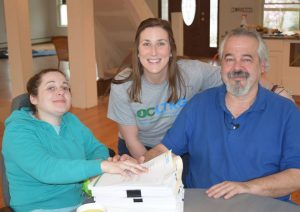“The money came and the money went, and nobody was watching.
Now, it’s a police problem.
That is the abridged version of the hurricane-related contractor fraud that has left thousands of homeowners stuck in the “disaster after the disaster” known as the Sandy recovery.
No place is it worse than sprawling Ocean County, where the storm left the most damage over the largest area.
“The government wanted to get recovery money into the hands of the people who were devastated as quickly as possible,” said Ocean County Prosecutor Joseph D. Coronato. “Unfortunately, there are people out there taking advantage of other people’s misery. They were victimized a second time.”
Coronato’s office has already secured 49 indictments involving Sandy-related fraud, and there are another 50 active investigations. Several small cases were previously adjudicated through restitution or the pretrial intervention, Coronato said, but the bigger cases are now being lined up for trials or pleas.
And while those numbers don’t seem staggering, the contractors are alleged to each have victimized an average of four to five homeowners. Several are accused of defrauding 20 to 30 clients. When you do the math, that’s thousands of people left holding the bag – a bag of empty promises and emptied of cash.
That’s just in Ocean County – it doesn’t even include another hundred or so cases in that are being handled by local police in the county.
MORE: Recent Mark Di Ionno columns
“We only take the cases that are multi-jurisdictional or if the fraud exceeds $75,000,” said Sgt. Mark Malinowski, who heads the county prosecutor’s office economic crimes unit, where cops with business degrees do the painstaking forensic accounting to build cases against people who made the recovery money disappear.
In short, the county only goes after the serial crooks. The small-time complaints get dealt with locally.
And the cases keep coming.
“Every time there is a new round of (recovery) funding, we get more complaints,” Malinowski said. “This isn’t going away anytime soon.”
The county has six investigators in the economic crimes unit and all have business or accounting degrees. They’ve all passed the Certified Fraud Examiners test – a 500-question marathon on how to detect slipshod financing and uncover shell-game bank accounts. There is also a required, yearly 20-hour continuing education program.
“It’s all about the education,” Coronato said. “This helps us track down drug money and financial schemes.”
But 50 percent of the unit’s work is now Sandy-related, Malinowski said. After fielding complaints, the detectives interview the homeowners and then the paper chase is on. The necessary act of discovering, subpoenaing and obtaining contractor bank records takes months, especially since many operate several LLCs.
Malinowski estimates the indicted contractors and those under investigation, have allegedly walked away with over $5 million.
Ocean County’s 15-mile barrier island, which stretches from Point Pleasant Beach to Island Beach State Park, provided the storm’s most unforgettable images. The Seaside Heights roller coaster in the ocean. The cedar-sided Mantoloking beach house in the bay. Ortley Beach homes scattered like Monopoly pieces.
But along the western front of the Barnegat Bay – and those uncounted miles of lagoons and bay inlets – the damage, while not as photogenic, was equally devastating.
Of the 40,500 homes rendered uninhabitable by the storm statewide, about half were in Ocean County. (The often-repeated number of 346,000 homes damaged by the storm is based on all insurance claims, major and minor.)
Towns that front the bay and beach rolled up staggering numbers of destroyed homes: Toms River (898), Brick (744). But towns with bay-only shorelines also were hit hard: Lacey (652), Ocean (499), Egg Harbor (349) and Stafford (307) were all swamped by the tidal surge in the bay.
The next surge was home repair contractors from across the state and the country, riding the waves of available money.
First, it was quick insurance payouts, or cashed-in investments or savings that homeowners used to get back home.
Then, it was the $2 billion in state and federal grants and loans to repair and elevate homes — and those are tax dollars — and that money keeps on coming. That’s what Malinowski means when he says every new round of financing brings new cases.
The state’s Rehabilitation, Reconstruction, Elevation and Mitigation (RREM) program has disbursed $945,833,994 to date. Recovery funds for multifamily and rental units total $151,391,198, and the $10,000 resettlement grants total $202,572,814 to date. The money keeps coming and the fraud keeps following.
In most cases, the homeowner receives a sizable check to get work started. And that’s where the problems begin.
“We have safeguards in place, but we can’t watch every dollar,” said Lisa Ryan, spokeswoman for the state Department of Community Affairs, which has handled the Sandy recovery.
“If a homeowner believes they have been defrauded by a contractor, they should immediately file a complaint with the NJ Division of Consumer Affairs,” she said. The consumer affairs number is (973) 504-6200 and the website is www.njconsumeraffairs.gov.
Ryan said the state has held several homeowner seminars on how to avoid fraud and has a webpage dedicated to it at renewjerseystronger.org/prevent-fraud.
But despite the warnings, people with hot cash in hand – and desperate to get back home – are bait in a shark tank.
“The checks are made out to the homeowner,” said Bill Scharfenberg, the Ocean County first assistant prosecutor handling the fraud cases. “They deposit the money in their accounts and are free to disburse it the way they want. They believe the contractors are bonded and state-approved. Some are, some are not.”
Coronato and Scharfenberg said some of the fraud is purposeful and some is not.
“We have guys who come in with low bids and run out of money,” Coronato said. “They take (money) from one job to finish another. Pretty soon, they can’t catch up.”
But, Scharfenberg added, “We’ve seen some money going into their lifestyles … new cars … vacations.”
Mary Lou Mickiewicz, of South Amboy, handed over $117,000 in RREM money to a contractor last year because she was already worn down from the process of filing insurance claims, dealing with FEMA paperwork and moving several times.
“He said he would take care of everything for me, all the paperwork, all the taxes, everything. So I trusted him,” she said.
She lives in Middlesex, but her case is being handled in Ocean County because the contractor is under investigation there, too, for disappearing on people such as Patty LaCourt of Lavalette.
“He talked a good game,” said LaCourt, who gave the same builder $110,000 to finish a job already started by another contractor who LaCourt said “wrecked my house.”
Joseph Ready, whose home in Union Beach is still unfinished, said his state-approved contractor kept asking for more to complete the job.
“What do you do? They said they ran out of money,” said Ready, whose $130,000 grant is gone. “So I gave them more. All I wanted was to get back home.”
Mark Di Ionno may be reached at mdiionno@starledger.com. Follow The Star-Ledger on Twitter @StarLedger and find us on Facebook.”
Like OCLTRG on Facebook!


